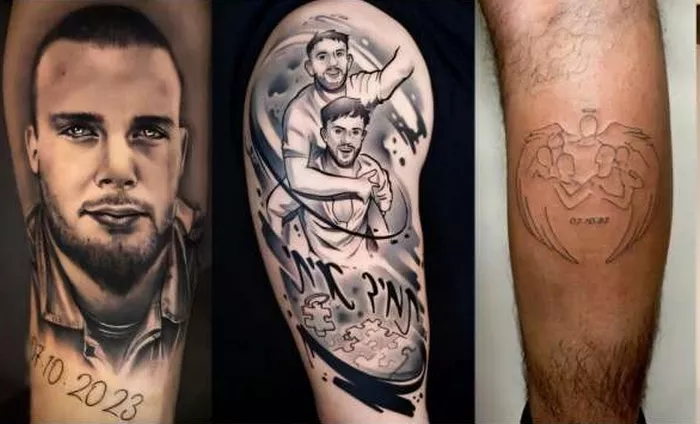Following the October 7, 2023, Hamas attacks on Israel, a wave of trauma swept the nation, affecting direct victims and the broader population alike. As many Israelis grappled with symptoms of post-traumatic stress, a shared experience of loss and resilience emerged, linking witnesses and survivors in a collective journey through grief and healing.
In the aftermath, a notable trend appeared: memorial tattoos. This body art, dedicated to loved ones lost or embodying broader themes of grief, hope, and endurance, has become a tangible expression of personal and national sorrow. Memorial tattoos serve not only as private tributes but also as symbols of shared trauma and solidarity within Israeli society.
A recent study in Death Studies by Dr. Ayelet Oreg, Dr. Hilit Erel-Brodsky, and Prof. Orit Taubman–Ben-Ari from Bar-Ilan University explores this phenomenon using Terror Management Theory (TMT), which suggests that awareness of mortality triggers existential anxiety, managed through cultural identities, self-esteem, and social ties. The study examines the surge in memorial tattoos in Israel post-attack, illuminating how these tattoos help people process trauma and reclaim a sense of meaning.
Collecting data from social media and analyzing 250 images of memorial tattoos, the researchers used digital ethnography and visual analysis to explore how these tattoos narrate experiences from the October 7 attack and its aftermath. The study identified three main themes:
Memorial Tattoos as Expressions of Cultural Identity
Many tattoos incorporate symbols tied to Israel’s collective memory, such as Holocaust symbols and Israeli national icons. Tattoos with Holocaust motifs, including yellow stars or the Star of David with “never again,” underscore a historical continuity of trauma, linking past and present. The date 7.10.23, a new painful marker, appears on many arms in a parallel to Holocaust-era identification numbers, strengthening the connection between past suffering and recent losses.
Other symbols, like the Jewish tefillin and barbed wire, evoke shared religious and historical themes. Tattoos depicting maps of Israel or images of lions—the latter symbolizing both the tribe of Judah and the Israel Defense Forces (IDF)—reflect national pride and resilience. These national symbols also communicate a sense of unity and collective strength in the face of tragedy, with one tattoo depicting a hand emerging from a grave gripping the Israeli flag, symbolizing survival and resistance.
Self-Esteem and Personal Identity
Memorial tattoos can also affirm self-worth, representing personal experiences and cultural pride. Tattoos commemorating specific battles or massacres, such as the tragedy at the Nova music festival, speak to individual roles in these events and serve as narratives of courage. One tattoo displays an explosion with fallen buildings and eleven angels, honoring soldiers lost, while another features a broken heart and the festival name “NOVA.” Other tattoos capture moments of shared hardship or loss, with symbols like red and black colors from the festival’s logo and phrases like “we shall dance again,” illustrating resilience and communal strength.
Some tattoos underscore themes of Jewish identity and personal triumph, as seen in one design that changes “impossible” to “possible.” Another bears the phrase “release our hostages” alongside a quote from Theodore Herzl, echoing Israel’s resolve and identity. A tattoo simply reading “home” next to a heartbeat symbol encapsulates resilience and the deep-rooted bond with one’s homeland.
Honoring Loved Ones and Places Affected by the Conflict
For many, memorial tattoos create a sense of closeness to deceased loved ones and places impacted by the conflict. Portraits of fallen soldiers and inscriptions like “Always with me” convey lasting connections, while images of the deceased as angels or companions reinforce the memory of those lost. Some tattoos feature locations significant to the tragedy, such as the police station in Sderot or Kibbutz Kfar Aza, serving as emotional markers of these affected places.
Tattoos of wheat or red poppies, referencing Israel’s agricultural heritage, link to a sense of hope and survival, symbolizing endurance amid hardship. These floral images are reminiscent of songs of resilience and represent a connection to the land’s natural beauty, which has become a symbol of strength and defiance.
Psychological Impact and Coping Mechanisms
Dr. Oreg, Dr. Erel-Brodsky, and Prof. Taubman–Ben-Ari observe that, like responses following events such as 9/11, memorial tattoos provide a channel for coping with extreme anxiety and loss. This study highlights the broader implications of TMT, examining how individuals manage grief and fear of mortality through the collective and personal meaning inscribed in their tattoos. As a testament to national endurance, these tattoosmark a psychological journey through trauma, contributing to understanding resilience strategies amid widespread crises.
Related Topics

